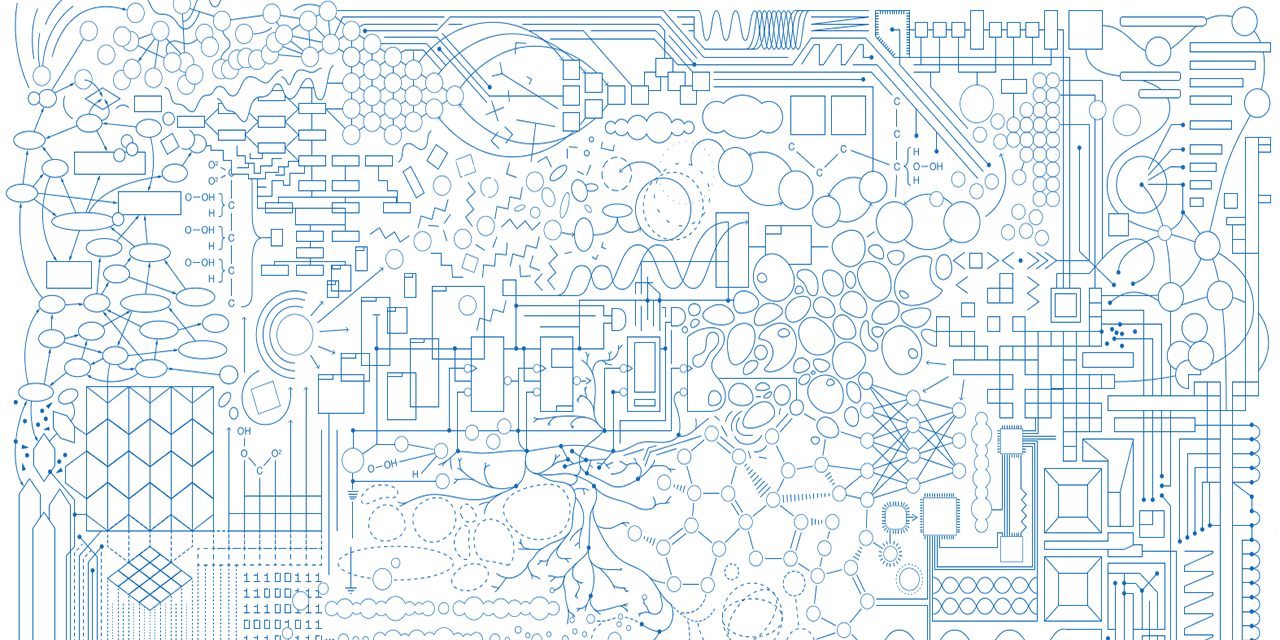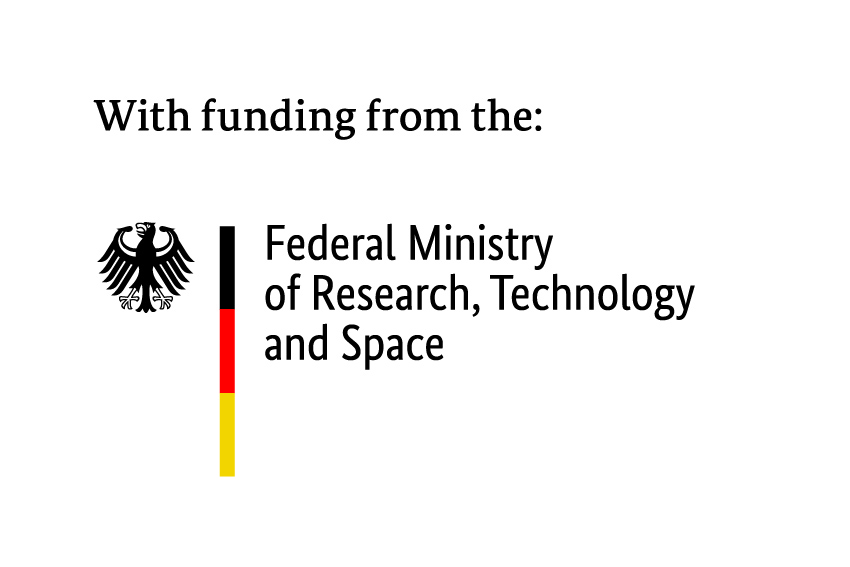The Notebook pt. 2: “I liked the idea of carrying my research in just one bag”

Academic writing is a basic practice that does not start in writing up one’s research results for publishing. Right from the start of an idea for a research project, researchers are noting down things: thoughts, questions, observations, ideas. Let’s have a look at the often neglected but very central object that inhabits these very first materializations of research ideas: the notebook. How does the notebook of a researcher look like? How do practices of note taking change in the digital age? I asked some of the fellows at the Käte Hamburger Kolleg: Cultures of Research (c:o/re) about their habits of note taking.

Markus Pantsar
Markus Pantsar is a philosopher of mathematics and artificial intelligence at the University of Helsinki, Finland. As a senior grant researcher, he worked on the epistemology of mathematics and will continue to do so with a focus on arithmetic and geometrical cognition with a funding by the Finnish Cultural Foundation that starts in autumn 2022. In the meantime, Markus tackles questions of complexity, human cognition and intelligence with regard to the development of artificial intelligence, simulation and machine learning during his fellowship at c:o/re.
Stefanie Haupt: Markus, what is the most recent thing that you noted down in your notebook?
Markus Pantsar: [thinks for a short moment and checks his notebook] It was something I wrote down from last week’s workshop. I usually take notes only sparingly. They are mostly personal reminders of things that inspire me when listening to talks – for example names or books and papers.
Stefanie: Your notes are handwritten but on a digital devise, how does that work for you?
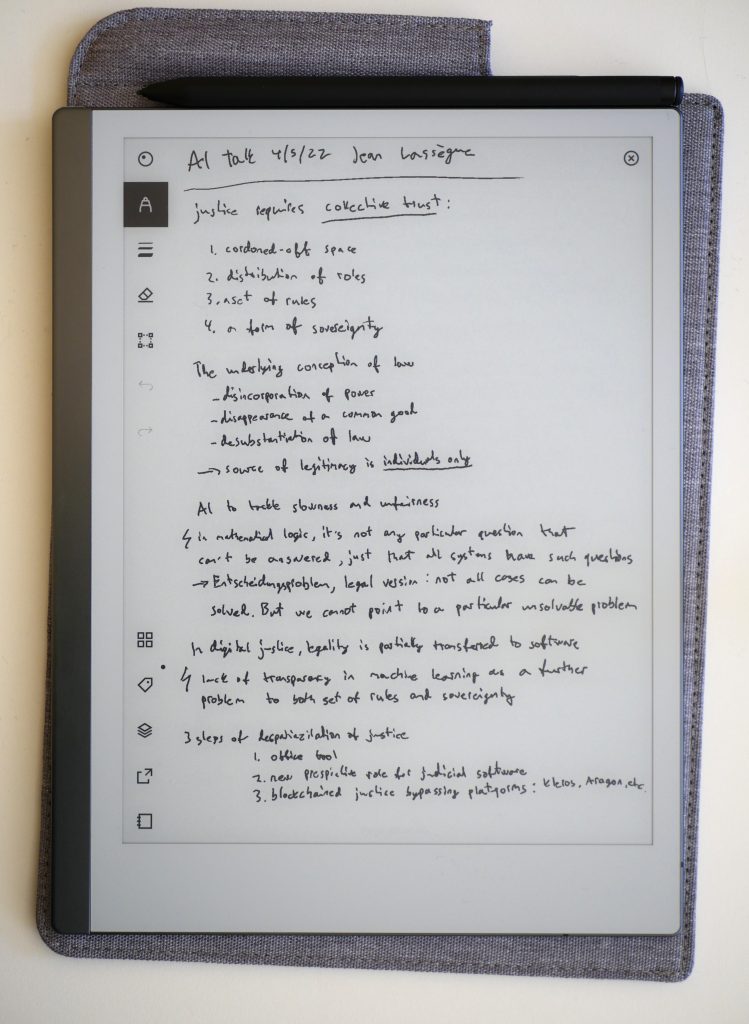
Markus: It works fine. I can either convert the pages to images or, and this is what I use mostly, the built-in AI transforms my handwriting to searchable type-written text. It just needs some editing afterwards. The software does not recognize, for example, names so easily. But otherwise, it works well for me.
Stefanie: And what happens after you convert the notes?
Markus: The software turns them into pdf-documents that I keep in different folders, for example, for conferences I attended. I also have a folder for my fellowship here in Aachen. Typically, I remember better where I heard interesting thoughts than when I heard them. Therefore, my folders follow a structure based on places rather than on pure chronology. I save everything in the cloud because I can see myself pouring coffee over my stuff [smiles].
Stefanie: I am looking at your desk right now and I see hardly any paper. When did you switch to the digital? Was it a conscious decision?
Markus: Yes, definitely. For me this is a very recent development. I bought this notebook in preparation for my fellowship in Aachen. I wanted something like this for a long time: a devise to write and to read digital papers and books on. Previously, I used to print articles and write into paper notebooks and they kept piling up in the bookshelf. But as a researcher you often have to move and switch places. I liked the idea of carrying my research in just one bag.
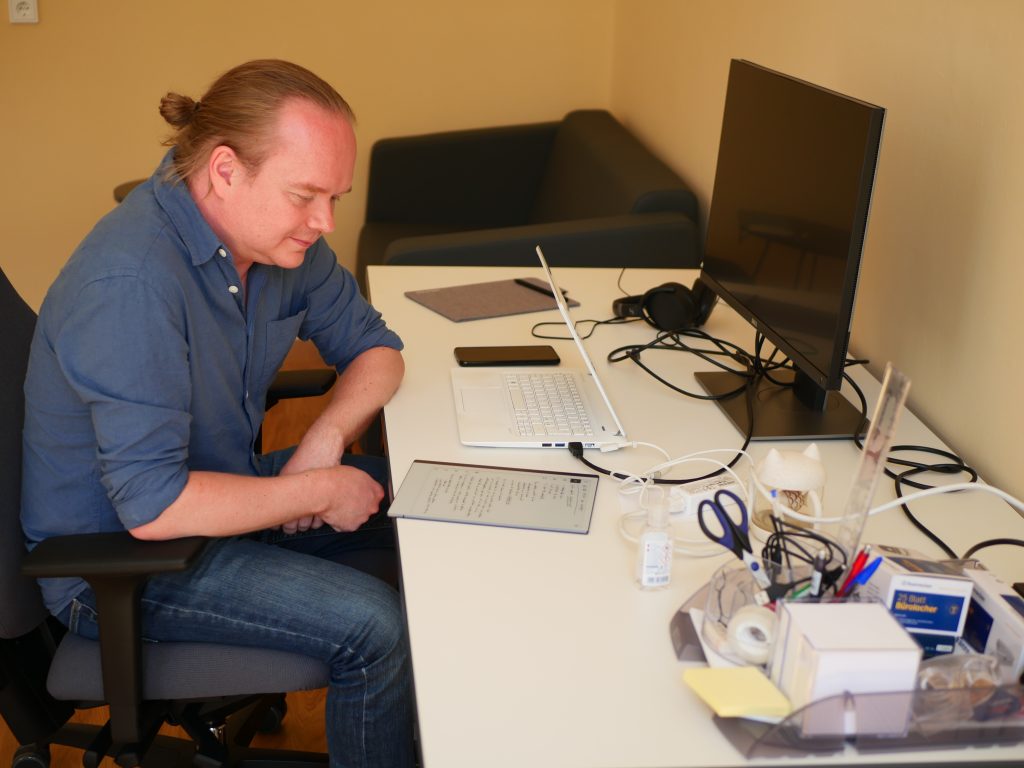
Stefanie: This is close to the ideal of the paperless office, which is also very ecological. Do you also see disadvantages compared to the analogue notebook?
Markus: Well, regarding the ecological factor you need to consider the production of such an electronic devise. Disadvantages – there aren’t many: The notebook won’t transform special symbols that the software does not recognize. For example, I use a kind of flash-symbol to mark points of disagreement with the arguments of others. Also, the notebook does not display colours, so whenever I read a paper and there is a coloured image, for example a graphic depiction of different activation areas in the brain, I am missing some of the information there. One disadvantage is also that for such a simple machine, it is still very expensive. It does not have internet access, aside from the cloud function for the files – but this is something I appreciate, actually: I can sit on the couch reading and not get distracted.
Stefanie: Did switching to digital change your practice of note taking somehow?
Markus: Now that we are talking about it, I would say: Yes, it did! Unlike with analogue notes, I have to go through the digital notes again to edit them after converting the text. This is necessary to find names and other keywords via the search function later. It has already become a kind of routine for me. And it also often prompts me to write down more about what I heard and inspires me to think deeper about it. I would say that now I am working more with my notes than before. But there is also a qualitative difference, in that my notes end up being more polished and easier to apply. I don’t think I will switch back to the analogue.
Stefanie: Thank you very much, Markus, for a short glimpse into your notebook!
The Notebook pt. 1: Taking Notes – “it’s a learned skill”

Producing, sharing, questioning, and contesting knowledge – in academia this is done mostly by writing and publishing papers. To make themselves heard in the academic world and to take part in scholarly debates, researchers have to write down their thoughts, ideas and suggestions to research problems and questions. Writing is an essential research practice. But rather than focussing on the finished product, the well composed text, edited, proof-read multiple times, peer reviewed, and published in a (most desirably high-impact) journal, let’s take a few steps back to the very beginning of a research project. What precedes even the “shitty first draft” of a written piece? I would like to look at the threshold where thoughts “materialize” and are written down for the first time. Let’s do this by shedding light on a particular object that is often overlooked when it comes to academic writing: the notebook. I interviewed some of the fellows at the Käte Hamburger Kolleg: Cultures of Research (c:o/re) about their note taking.
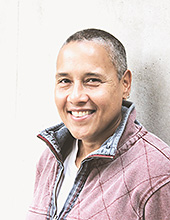
Catharina Landström
Catharina is an Associate Professor of Science and Technology Studies at Chalmers University in Gothenburg, Sweden. Prior to that, she was as senior researcher at the School of Geography and the Environment at the University of Oxford, England. Right from the start of her professional carrier, she has conducted a lot of field work, for example on water challenges such as flooding, draughts and water quality. At c:o/re she explores how environmental scientists present and convey results from- and tools of computer simulation modelling for decision making processes
Stefanie Haupt: Catharina, when I saw you with your notebook during the c:o/re Lunch Talks it really fascinated me how neatly you were taking notes. Your notebook has lined pages in an A4 format. Do you prefer a certain type of notebook?

Catharina Landström: I do take notes on any sort paper I can get hold of! Normally, I just use what I can find: binders that came as a kind of gift at conferences etc., or I use whatever I can find in the storage of the university. I prefer writing on lined paper. Squared paper does not really work for me. And blank paper – I get paralyzed when the page is empty! Papers with a column on the left side are quite nice for making comments. I like taking notes in wire bound notebooks. Then I can easily take out the page because, depending on the topics I am working on, I collect the pages on different piles. I also have different notebooks for different topics and tasks, for example for the different PhD projects that I supervise. The notebook you saw in the Lunch Talk is my c:o/re notebook.

Stefanie: When did you start taking notes and in which situations do you use your notebook? You did a lot of field work. Did you also bring a notebook when you were out in the field?
Catharina: Right from the beginning of my studies I took notes. But the way I do changed much over the time: I remember in my PhD project while working in the field, I took so many notes, I sometimes could not make sense out of them afterwards. The field is a difficult place for taking notes. It is a really stressful work. Everything that happens “passes” through you. In the field you are the tool. And notes are more than notes. So, I tried to capture everything. Today, I take less notes but they are more precise. It is really a learned skill.
Stefanie: So, what is it that you note down?
Catharina: Thoughts. Thoughts of others, my own thoughts while listening to a talk for example. My notes help me to remember better. For example, I note down what I discuss with my PhD students. I also write down ideas for project proposals. By going through them, my notes help me to further develop ideas.
Stefanie: Did you develop a kind of private system? Like a colour code? And how do you further process your notes?
Catharina: A colour code would require having a fixed set of colour pens with me all the time – so, no. But when I listen to talks and note down what I hear, I distinguish the thoughts of others from my own by putting mine in squared brackets. Questions that arise come in round brackets. The notes I take are only for myself. I switch to the digital when I want to further develop ideas for myself or when I want to share them with somebody else.
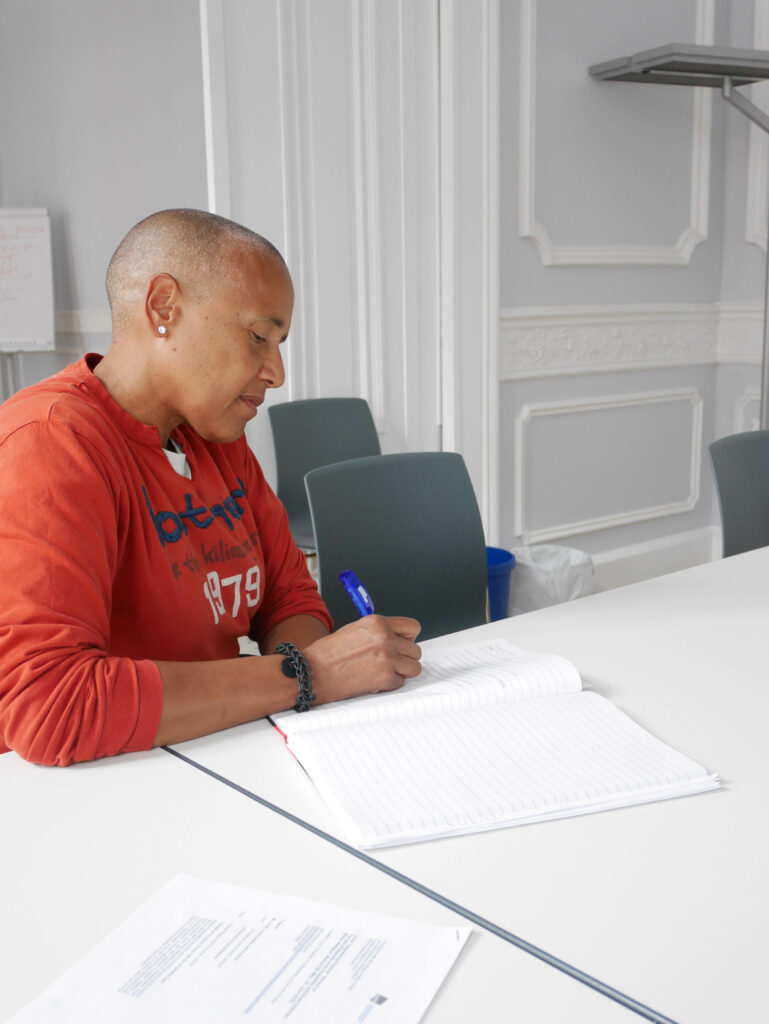
Stefanie: Do you keep your notebooks?
Catharina: I keep them for a while. Everything is time limited, you know. Then comes the time when you can either store your notebooks in a box in the attic or throw them away. Once I suggested to a friend to throw away the notes she took during an interview project in the 90s. She was really irritated by this suggestion.
Stefanie: You told me that you were wondering at some point if you might also switch to the digital for note-taking, too.
Catharina: Oh, I did. Everybody brings their (laptop)notebook to academic discussions today. I tried that for a while, too. But I noticed that I never go back to look at digital notes again [Catharina laughs]. I don’t know what it is, maybe it is the paper, the feel, the way you can browse through the pages. It has a different quality somehow.
Stefanie: Thank you, Catharina, for your time!
Introduction to the concepts of Open Science, Responsible Research and Innovation and Anticipatory Governance
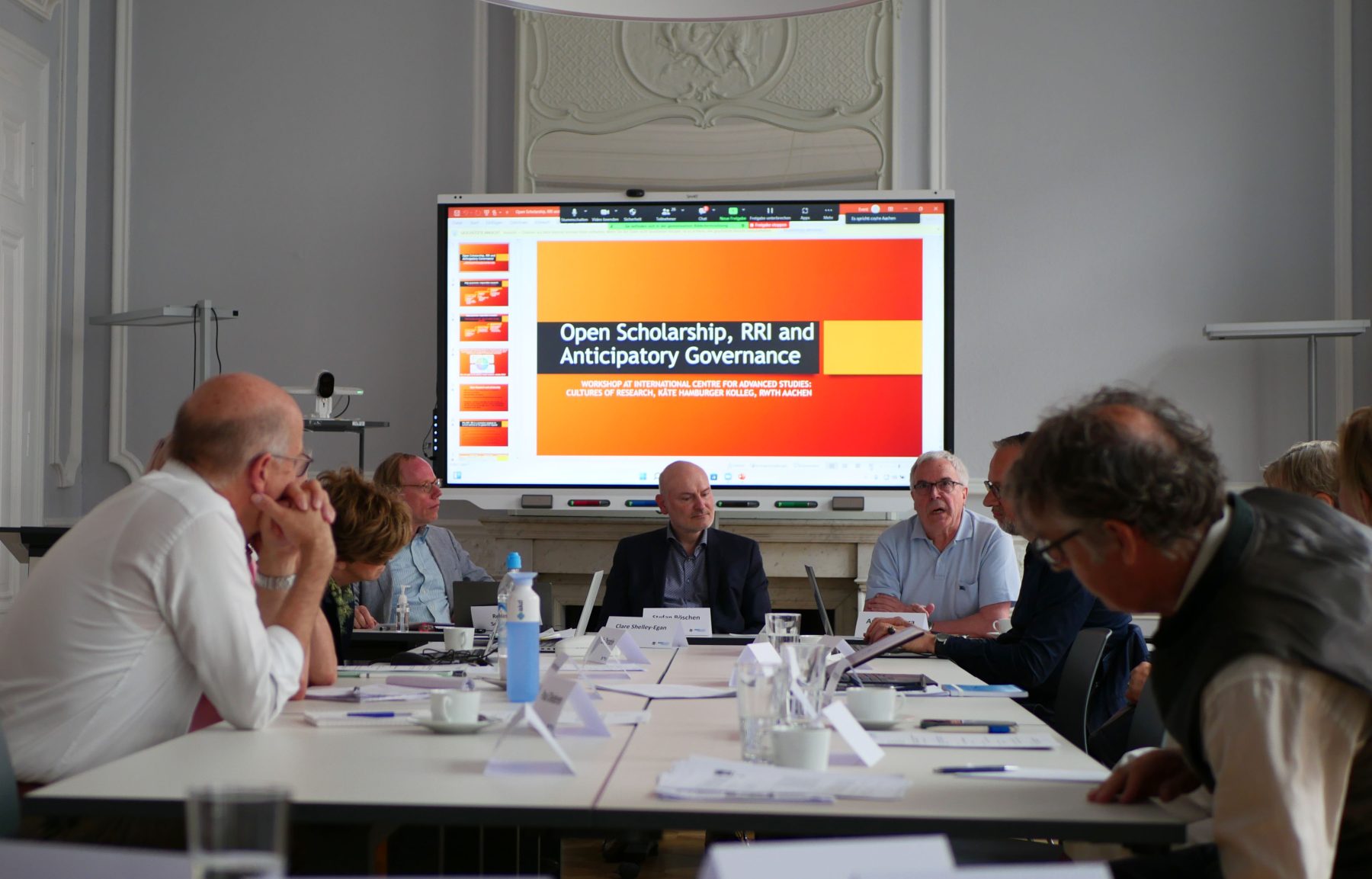
RENÉ VON SCHOMBERG AND ANDONI IBARRA
Responsible Research and lnnovation (RRI) has become increasingly important since it was introduced as a cross cutting issue under the European Union (EU) Framework Programme for Research and Innovation “Horizon 2020” (2014-2020). Subsequently, it became an operational objective of the strategic plan for “Horizon Europe (2021-2027)”, the new EU Framework Programme for Research and Innovation. ln EU member states, there are also various initiatives supporting RRI, notably under schemes of national research councils (the United Kingdom, Norway, and the Netherlands, among others). The concept also resonated outside the EU, notably in the United States, and in China it became part of the national five-year plan for Science, Technology and Innovation.
However, there are a variety of approaches as for how it should be implemented. Scholars provide a variety of perspectives and assessments of what RRI need to address. However, all scholars generally share the notion that RRI requires a form of governance that will direct or re-direct innovation towards socially desirable outcomes. This initial definition that Von Schomberg provided in 2011 captures the commonalities of the field:
Responsible Research and Innovation is a transparent, interactive process by which societal actors and innovators become mutually responsive to each other with a view to the (ethical) acceptability, sustainability and societal desirability of the innovation process and its marketable products (in order to allow a proper embedding of scientific and technological advances in our society).
This definition was not proposed as an end-result but as a starting point for an ever-growing field of research and innovation actions. The definition was put forward, first, to highlight that dominant public policies only negatively select science and technology-related options, notably by the management of their risks. According to the still dominant ideology, all innovation will contribute to common prosperity regardless of its nature. The notion of responsible research and innovation makes a radical break with such an ideology. Furthermore, this ideology tells us that innovations cannot be managed or be given a particular direction. Also on this front, the notion of responsible innovation breaks with this ideology and puts the power for a socially desirable change through innovations into the hands of stakeholders and engaged citizens. However, these stakeholders have to become, or be incentivized or even enforced to become, mutually responsive to each other in terms of social commitments to such change.
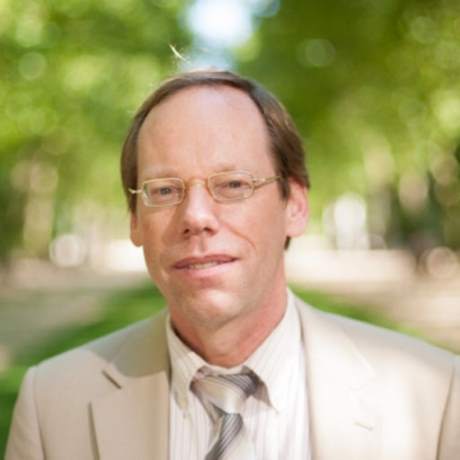
René von Schomberg
René is Guest Professor at the Technical University of Darmstadt, Germany. He was a European Union Fellow and Guest-Professor at George Mason University, USA, from 2007 to 2008 and has been with the European Commission from 1998 to January 2022. In his research project as a senior fellow at c:o/re, he focusses on the values of “openness” and “responsibility” in science policy.
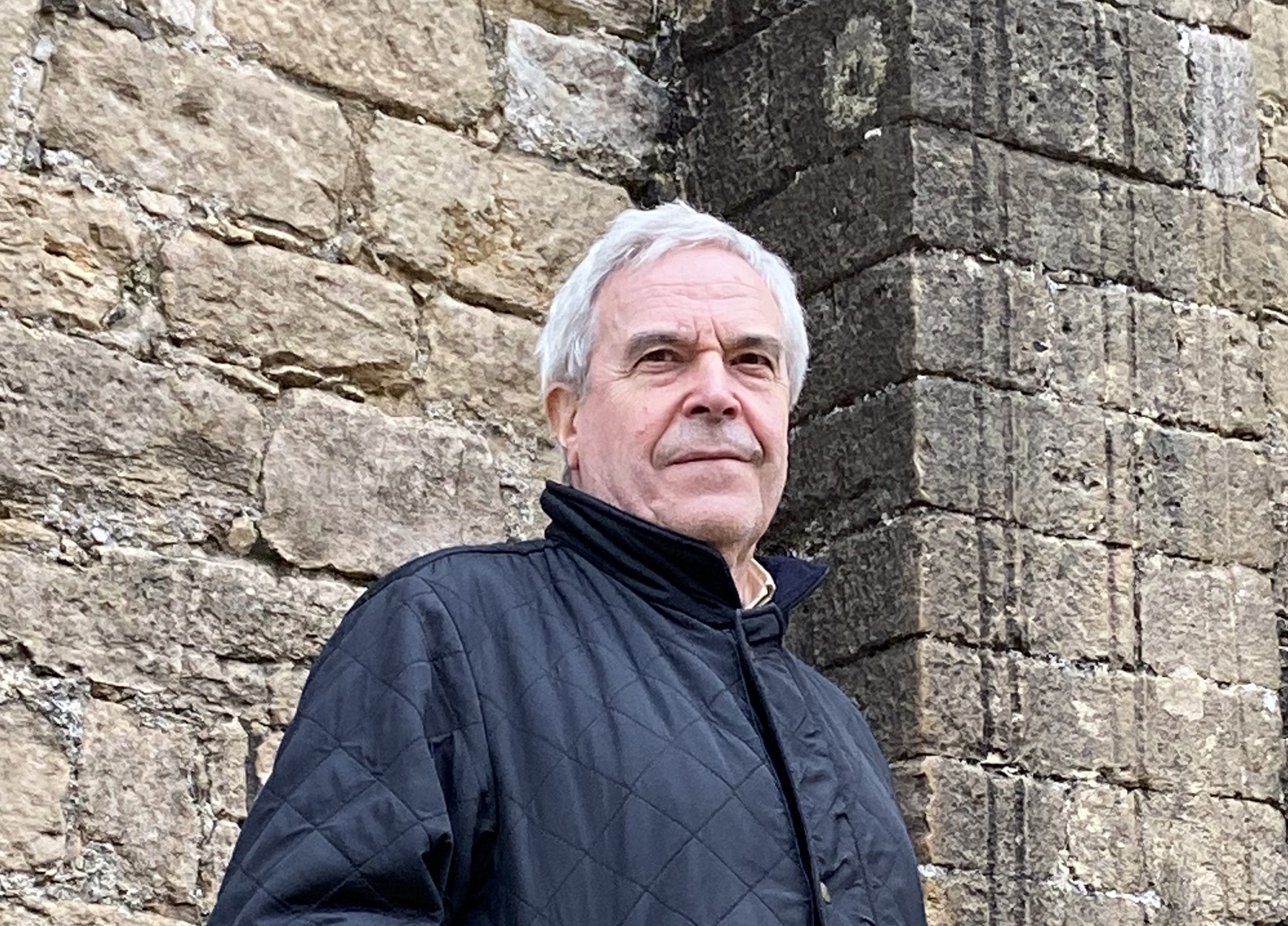
Andoni Ibarra
Andoni is Professor of Philosophy of Science at the University of the Basque Country (UPV/EHU). He is also the Principal Investigator of PRAXIS Research Group, the founder of the Miguel Sánchez-Mazas Chair. As a senior researcher at c:o/re, he is developing an anticipatory governance framework aimed at assessing and guiding the implementation of responsible anticipatory practices in research and innovation in the field of nanotechnologies.
Responsible Research and Innovation (RRI) imposes normative requirements on research and innovation processes resembling three successive steps of an incremental higher ambition with distinct features. The distinct features reflect the normative requirements of firstly, credible research (through among others ‘codes of conduct’ and standards for scientific integrity), secondly responsive research (by opening up science to societal demands), and finally responsible research (which includes the anticipation on socially desirable outcomes) for the research dimension. Equally distinct features reflect the requirements of credible innovation, responsive innovation, and responsible innovation (Von Schomberg, 2019).


For each of these steps, a framework for good practice is needed. The contributions to the workshop “Open Scholarship, Responsible Innovation and Anticipatory Governance” that took place on June 29-30, 2022, at the Käte Hamburger Kolleg: Cultures of Research, can be seen as attempts to contribute to these good practices for a single step or for multiple steps. First, the creation of knowledge in science underlies distinct universalizable codes for ‘good’ research conduct, enabling a global research practice that is virtually independent of cultural and national constraints. As the previous director of the US National Science Foundation Subra Suresh put it: ‘Good science anywhere is good for science everywhere’. The issue of ‘what is good science?’ can be seen as purely internal matter of the scientific community. Indeed, it has always been scholarly societies or academies of science who have tackled this issue of credible research, which arguably also constitutes the most basic requirement of RRI.
However, we should not forget these scholarly societies and other scientific institutions only engaged with the internal issue of good scientific conduct and scientific integrity because of external societal pressure and clear ethical challenges. That this is an issue which is far from settled.
Yet, Responsible Research and Innovation with within its dimension of ‘open scholarship’ has put additional pressure on revising or extending the normative requirements of this first step for RRI governance, namely credible research and thereby calling for revision of existing codes of conduct for good science particular with a view on achieving credible, reproduceable and re-usable data, all necessary to enhance science as such.
Open research and scholarship can be defined as ‘sharing knowledge and data as early as possible with all relevant knowledge actors‘ (Von Schomberg, 2019). Open research and scholarship (in the research policy-making context often simply referred to as ‘open science’) is operationalised by researchers who use, re-use and produce open research outputs such publications, software and data and who engage in open collaboration with other scientists, as well as seek, whenever appropriate for the subject matter of study, open collaboration with knowledge actors external to science such as industrial organisations, civil society organisations or public authorities.
During the Covid-19 pandemic, we have witnessed a change in the modus operandi of doing science as public authorities started to incentivize open science globally. This made it possible to deliver swiftly on vaccines. Without open science, the market introduction of these vaccines would have taken, under the usual circumstances of competitive and too closed forms of science, minimally a decade.
The research value ‘openness’ can be seen as a constitutional value for the scientific community as such. Open scientific discourse, the exchange of ideas and competing approaches is fundamental for the progress of modern science. ‘Openness’ is presupposed by the Mertonian norm ‘Communism’ (common ownership of scientific discoveries) and thus part of the ethos of science (Merton, 1942). However, the meaning of ‘openness’ is manifold and is dependent on the scientific discipline or the scientific mission in which it is embedded. With the emergence of Open Science, equally ethical issues concerning the limits to ‘openness’ in particular contexts become evident, such as the employment of sensitive data in security or biomedical fields.
Open research and scholarship manifest itself notably in the case of interdisciplinary scientific cooperation with a view on developing a socially desirable output as the case of Covid-19 demonstrated. Open research and scholarship have been incentivized with a view of making science more efficient (better sharing of resources), more reliable (better verification of research data) and making it more productive with a view on a socially desirable output (in this case a vaccine). Research virtues or norms have been phrased historically as a subset of general human virtues. From the Mertonian CUDOS norms (Merton,1942) to the codified principles of research integrity incorporated in the All European Academies’ European Code of Conduct for Research Integrity, norms or principles have been described as a fundament of a ‘good’ research practice. The ‘responsibility’ of the scientific community is then often described as an overarching duty to promote, manage, and monitor a research culture that is based on the scientific integrity of its members (ALLEA, 2017). Furthermore, research integrity does include a particular form of responsibility, namely the accountability for the whole internal process of science from idea to publication. The ‘implementation’ of scientific integrity is managed by self-regulation of the scientific community.
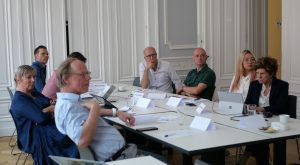
Traditionally the scientific community has stopped short of taking any form of responsibility for consequences and side-consequences of the societal use of scientific insights and technologies and its unpredictable societal impacts. The responsibility for those consequences has been ‘allocated’ to the political system. This division of responsibilities has become subject of intense debate, virtually since the whole period after Word War II. Intense debate on the risks of emerging technologies have led to the adoption of national laws and European directives on the risks, the quality and efficacy of products arising from the use of new technologies. Western societies have gained the capacity to indirectly govern emerging technologies, notably through its risk management and to outlaw specific undesirable outcomes, such as cloning human beings. Our institutions have thus governance structures in place to manage the risks of technologies such as nuclear technology, genetic or nanoengineering. However, we do not have established capacities to anticipate or direct science and innovation towards socially desirable outcomes such as vaccines or outcomes that underpin or make the transition towards sustainability possible. Responsible Research and Innovation (RRI) has emerged as response to this deficit in the governance of science and technology. RRI requires a form of governance that will either direct science towards socially desirable outcomes or manage innovation processes in such a way that those socially desirable outcomes are more likely to emerge (Von Schomberg 2019).
It is therefore desirable to develop further a governance framework which institutionalizes the organization of co-responsibility across the spheres of science, policy and society on a subject matter which require open science missions such as Covid-19. The institutionalization of co-responsibility requires a governance which goes beyond self-regulating mechanisms within science itself. There is a ‘responsibility’ for ‘organizing co-responsibility,’ shared by scientific, policy and societal actors. The institutionalization of this responsibility will have consequences for the way science is funded and organized, for example through policy and financial incentives to embark on socially relevant open research missions. For example, by means of co-creation and co-design of research agendas with scientific, policy and societal actors which are currently foreseen in the “Horizon Europe (2021-2027)” program. An important aspect is the governance of the research missions themselves. When open research missions are conducted to achieve a socially desirable objective, its governance and organization will significantly have to differ from research missions with a primary technological objective (for example: ‘putting a man on the moon’). In fact, the ultimate step to complete RRI with anticipatory governance is inherent for this type of mission-oriented research.
The governance of research of innovation based on a Framework of RRI thus requires credible research, open and responsive research and responsible research that anticipates socially desirable outcomes. This anticipation also presupposes that such research and innovation is inevitably value-driven as those values mark the desirability or undesirability of research and innovation outcomes.
The desirability of open scholarship is often motivated by the wish to achieve better scientific practices. However, RRI is more ambitious and represents an effort to drive research and innovation towards socially desirable outcomes. We, therefore, must address the question how we can define these outcomes, for example by the way we anticipate them. The employment of foresight is one of the few tools we have at our disposal, and possibly the most robust one. Broadly speaking, anticipation can be defined as an activity characterized by the use of the future (or futures) to guide and orient decision making in the present. Anticipation must therefore be distinguished from forecasting.
The question of socio-technical futures is critical in this context because the ways in which scientific and technological practices are articulated derive from the anticipatory capacity, that is to say, from the capacity to promote certain research and innovation trajectories in the present on the basis of visions and expectations regarding future promises. Therefore, anticipatory responsibility goes beyond the traditional tendency to approach responsibility as a mere regulatory exercise; an exercise in which the socio-economic justification of scientific or technological innovations is not problematized, on the basis of future promises linked to them. This activity of futures building opens the door to publics. Anticipatory governance is an instrument for the engagement of publics in the exercise of opening science and innovation that should contribute to a more robust articulation of the relations between societal actors.
Anticipatory innovation processes are understood as open and deliberative processes, in which the values, motivations and expected benefits of innovations appear to be subject to public scrutiny. As such, the understanding of those anticipatory innovation processes emphasizes the need to critically and openly analyze the ways in which socio-economic and environmental challenges and their potential solutions are established. This implies recognizing anticipation as a fundamental component of responsible governance; a component that enables the construction of “socio-technical futures” as a guide for decision-making in the present. It is fundamental because anticipation becomes the component that modulates the degree of responsibility of responsible open scientific-technological practices. However, despite its central relevance, the meanings of anticipation and anticipatory governance are divers, often disparate, if not contradictory, as Mario Pansera showed in his presentation.
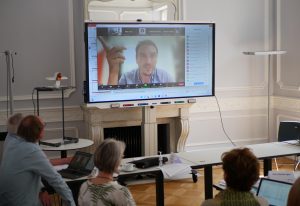
In this context of plurality of meanings, the risks of the very concept of anticipatory governance for the achievement of more responsible science and innovation should not be forgotten, as Alfred Nordman and others have shown. Not only because some anticipatory governance understandings close down the field of possible alternatives and courses of action. (We can call them closed anticipatory governance patterns.) The risks arise above all, however, because anticipatory governance is permanently connected to the risk of instrumentalisation by an innovation system highly committed to techno-industrial developmentalism and economic competitiveness. Therefore, its contribution to responsible science and innovation and its transformative potential should not be taken for granted. Attention needs to be paid to the way in which power relations and instrumentalisation dynamics characteristic of innovation systems tend to exclude, or to close down, the emergence of alternative ways of approaching scientific-technical co-creation. That’s why, among other things, the transformative potential of anticipation towards more responsible forms of scientific practice has to remain analyzed and explored.
Reference
All European Academies (2017), The European Code of Conduct for Research Integrity: https://allea.org/code-of-conduct/
Burgelman J-C, Pascu C, Szkuta K, Von Schomberg R, Karalopoulos A, Repanas K and Schouppe M (2019), Open Science, Open Data, and Open Scholarship: European Policies to Make Science Fit for the Twenty-First Century. Front. Big Data 2:43.
Merton, Robert K. 1979 [1942]. “The Normative Structure of Science.” In The Sociology of Science: Theoretical and Empirical Investigations. Chicago: University of Chicago Press.
Von Schomberg, R (2019), Why responsible innovation in: R. Von Schomberg and J. Hankins (eds) International Handbook on Responsible Innovation: A Global Resource. Cheltenham: Edward Elgar, pp. 12–32.
Rene runs a blog with free downloadable resources on RRI: https://Renevonschomberg.wordpress.com
proposed citation: René von Schomberg and Andoni Ibarra (2022). Introduction to the concepts of Open Science, Responsible Research and Innovation and Anticipatory Governance. https://khk.rwth-aachen.de/2022/07/25/3892/3892/
Engineering Practices Workshop: The Use of Networks in the Humanities and Social Sciences
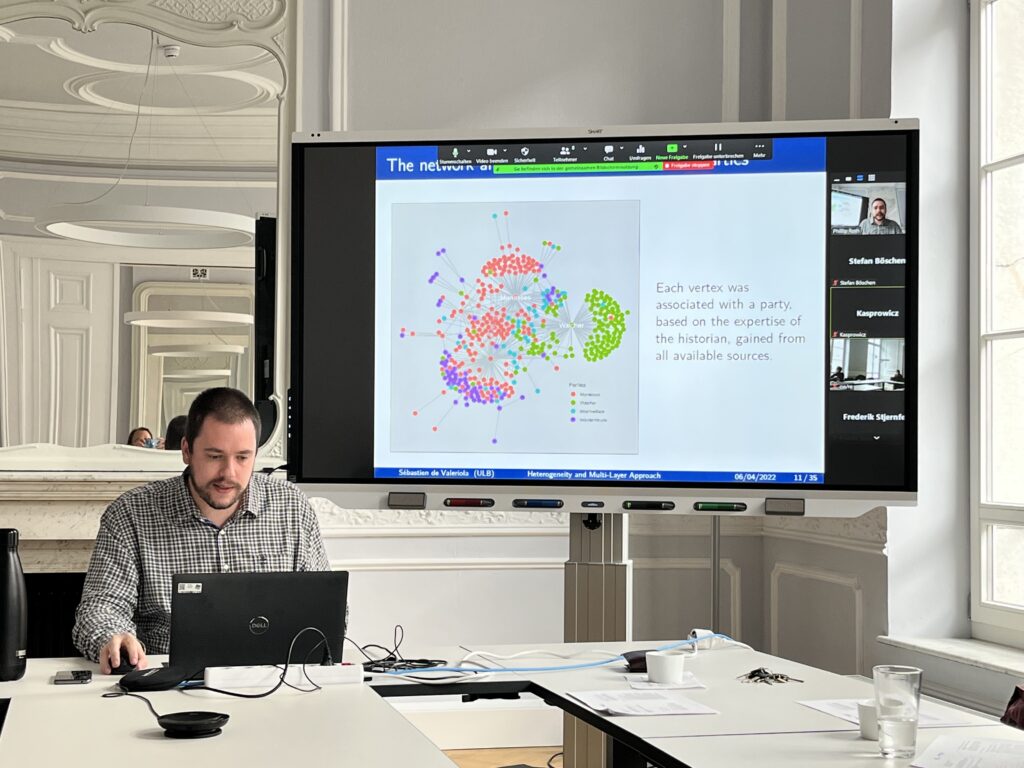
Middle Ages: A Multi-Layer Network Approach”
On May 30th – June 1st, c:o/re hosted the workshop The Use of Networks in the Humanities and Social Sciences, part of the Engineering Practices series and organized by Professor Ana Bazzan together with Phillip H. Roth and Alin Olteanu.
The aim of the workshop was to chart the use of networks in the humanities and social sciences and the consequences of the use of such epistemic tools for the way we understand science, society and the world. As such, the event gathered a variety of perspectives on networks and applications of network analysis, from the mathematics of networks to media analysis, historical research and to tackling questions on technology.
A point of convergence among these varied approaches is that, as models, networks have become a central epistemological tool in many sciences as well as vernacularly, not least because of the mainstreaming of social media and their role in networking communities and academic disciplines across previously established boundaries. A particularly interesting takeaway point of this workshop is that, as models and as representations, networks have become a common analytical tool in many fields of research, thus allowing for multi-perspective discussions on methodology.
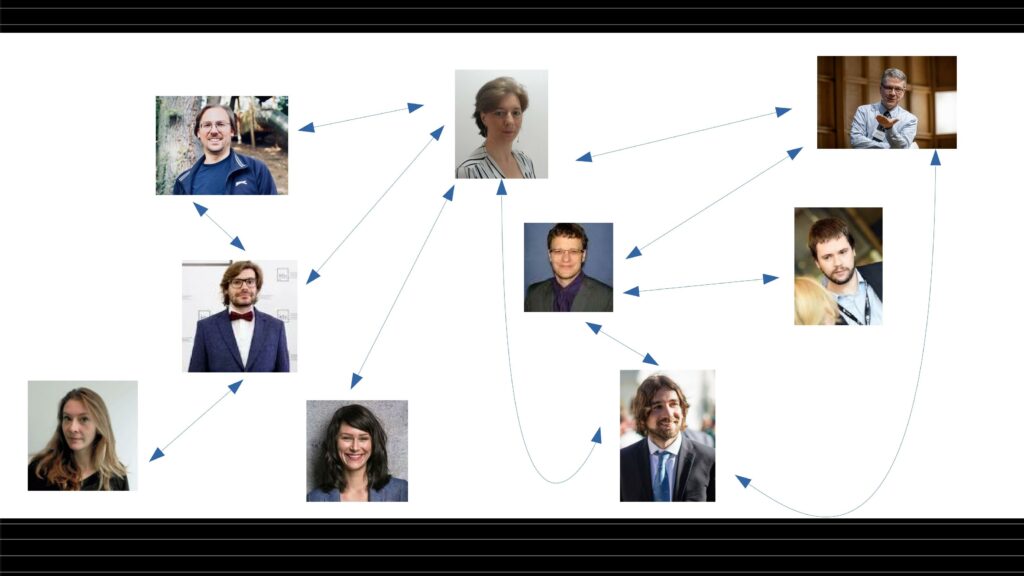
Review of Amanda Boetzkes’ Plastic Capitalism (2019) – “Art in the petrotimes”
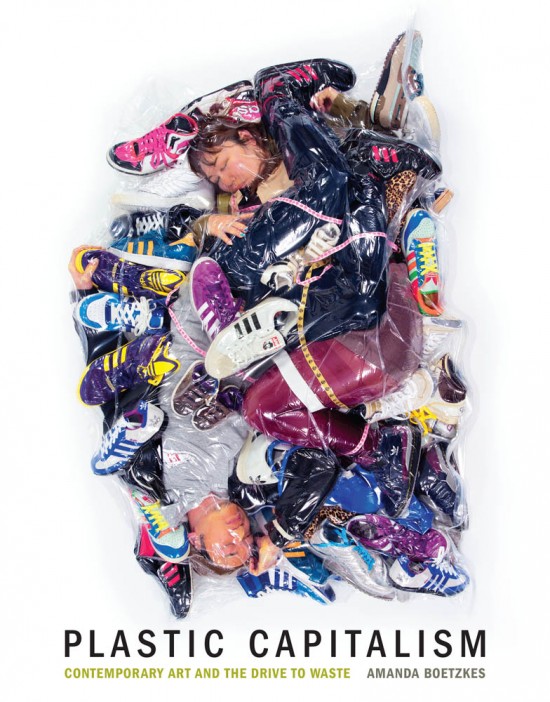
Sara Bédard-Goulet published a thorough and insightful review of c:o/re fellow Amanda Boetkes‘ (2019) Plastic Capitalism Contemporary Art and the Drive to Waste in the journal Social Semiotics. The review, titled Art in the Petrotimes: An aesthetics of waste, is here.
Book launch: The world’s first full press freedom
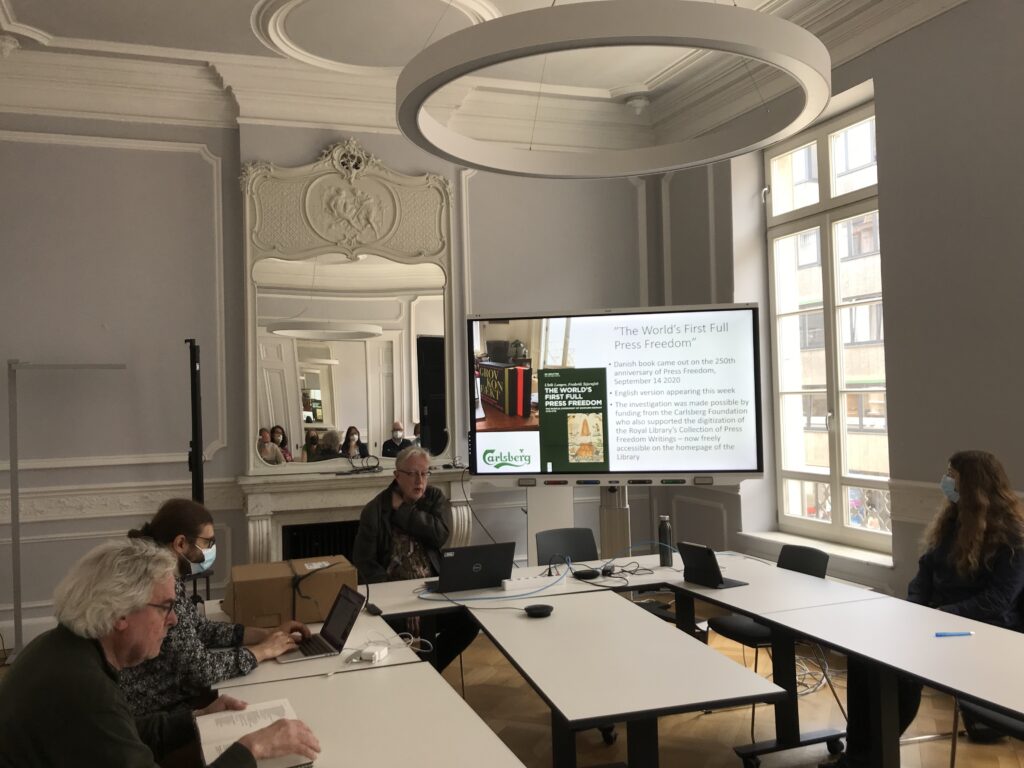
We had a book launch at c:o/re, as Ulrik Langen and Frederik Stjernfelt‘s book The World’s First Full Press Freedom: The Radical Experiment of Denmark-Norway 1770-1773 is being published this week. Frederik Stjernfelt gave a thorough presentation of the book on 25.05.2022. This was a particularly appropriate date for a discussion on press freedom as, on the same day, in Aachen, there took place the ceremony of conferring the International Charlemagne Prize to the leading Belarusian political activists Maria Kalesnikava, Sviatlana Tsikhanouskaya and Veronica Tsepkalo, who lead the fight for democracy in Belarus.
This is an adaptation for international audiences of their previous book written in Danish, also together with Henrik Horstbøll, comprising two volumes, Grov Konfækt. Tre vilde år med trykkefrihed, 1770-73. To address an international audience, Ulrik Lange and Frederik Stjernfelt both reduced the size of the initial text and, also, approached some new topics, to do with the international reactions to the episode of the history of Denmark-Norway (The Oldenburg Monarchy) that the book discusses.
The book offers a historical investigation of the interesting episode in the history of Denmark-Norway when Press Freedom was introduced by the German Radical Enlightener J.F. Struensee, who was hired in 1768 to take care of the mental health of King Christian VII. Struensee became the King’s favourite and achieved political power, backed also by a small group of reform-oriented top officers. This allowed Struensee, for a brief 16-months period, to effectively be dictator of Denmark-Norway and, as such, to introduce close to 2000 pieces of new legislation, many of them with Radical Enlightenment inspirations.
In this context, the book zooms in on the implications of and reactions to the law of 14 September 1770 that stated that censorship is abolished in order to facilitate the ”Impartial Investigation of Truth”, to go against ”Fallacies and Prejudices of earlier Times”, and to ”attack Abuse and reveal Prejudices”. This was an Enlightenment ideal. Struensee could not have foreseen, probably, the many types of social implications of absolute press freedom. He was, eventually, ousted and executed by coup-makers in the middle of the Press Freedom period.
Showing simultaneously how press freedom is crucial for democracy and human rights and how it is also dangerous, the exploration of this historically first case of full press freedom is highly relevant for contemporary debates on freedom of expression online and post-truth attitudes. The detailed investigation that the book offers relies on an impressive categorisation of about 1000 pamphlets published during this press freedom period.
As the first book on the matter, in Danish, covers in great detail the events in Denmark-Norway of this historical episode, the new English adaptation also compares the Copenhagen pamphlet storm of 1770 with the pamphlet storms that took place in Vienna in 1781 and in Paris in 1788.
The authors explain that, in all three cases, Enlighteners introducing Press Freedom were disappointed with the result. The population hardly became more moral and enlightened, but rather used freedom to split into warring factions, to print and buy cheap entertainment, libel and obscenities. Also, in all three cases, an immediate explosion of prints waned over a number of years, finally to be restricted again by different means, such as post-print censorship, prohibition of anonymity, signal cases, taxation, licensing requirements, among others. However, very importantly, all three cases made clear the modern consequences of Press Freedom as it would spread in Western democratic constitutions through the 19th Century.
The book draws many relevant conclusions on freedom of speech in general. As particularly relevant for contemporary issues, the book argues that press freedom is not natural, nor automatic. There is always a pretext to curtail it, and every government may find reasons to do so.
Press freedom is unpredictable and cna involve many types of of drawbacks, such as libel, threats, calls for sedition, fake news. To this day, (full) press freedom is contested: there is no agreement about its limits. Press freedom creates a public sphere, drawing people to consider political options and to conceive themselves as political subjects.
Summarising, the book highlights the importance of accepting conflict as part and parcel of the democratic process and the pursuit of human rights. Press freedom is instrumental in this regard, as it connects to a conflictual view of society: there are and always will be different social strata, different political positions, different interest groups, different power centers and their conflict is better waged in the open.
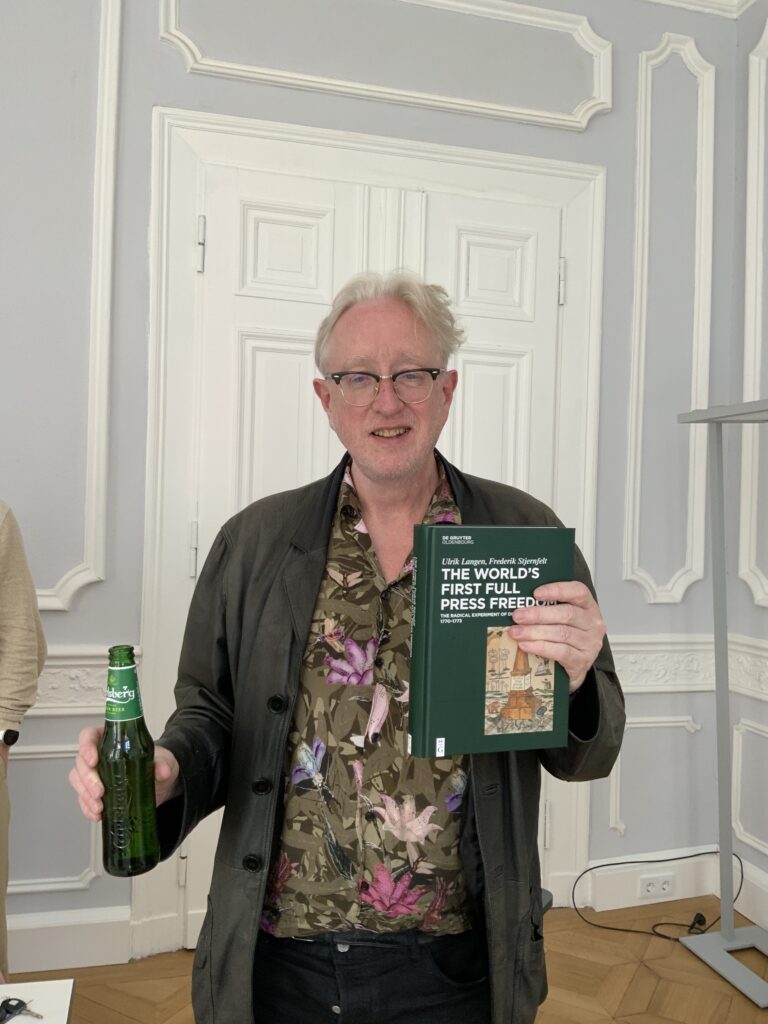
Getting the Measure of Humanity: or, Taking ‘Life is a Work of Art’ Literally
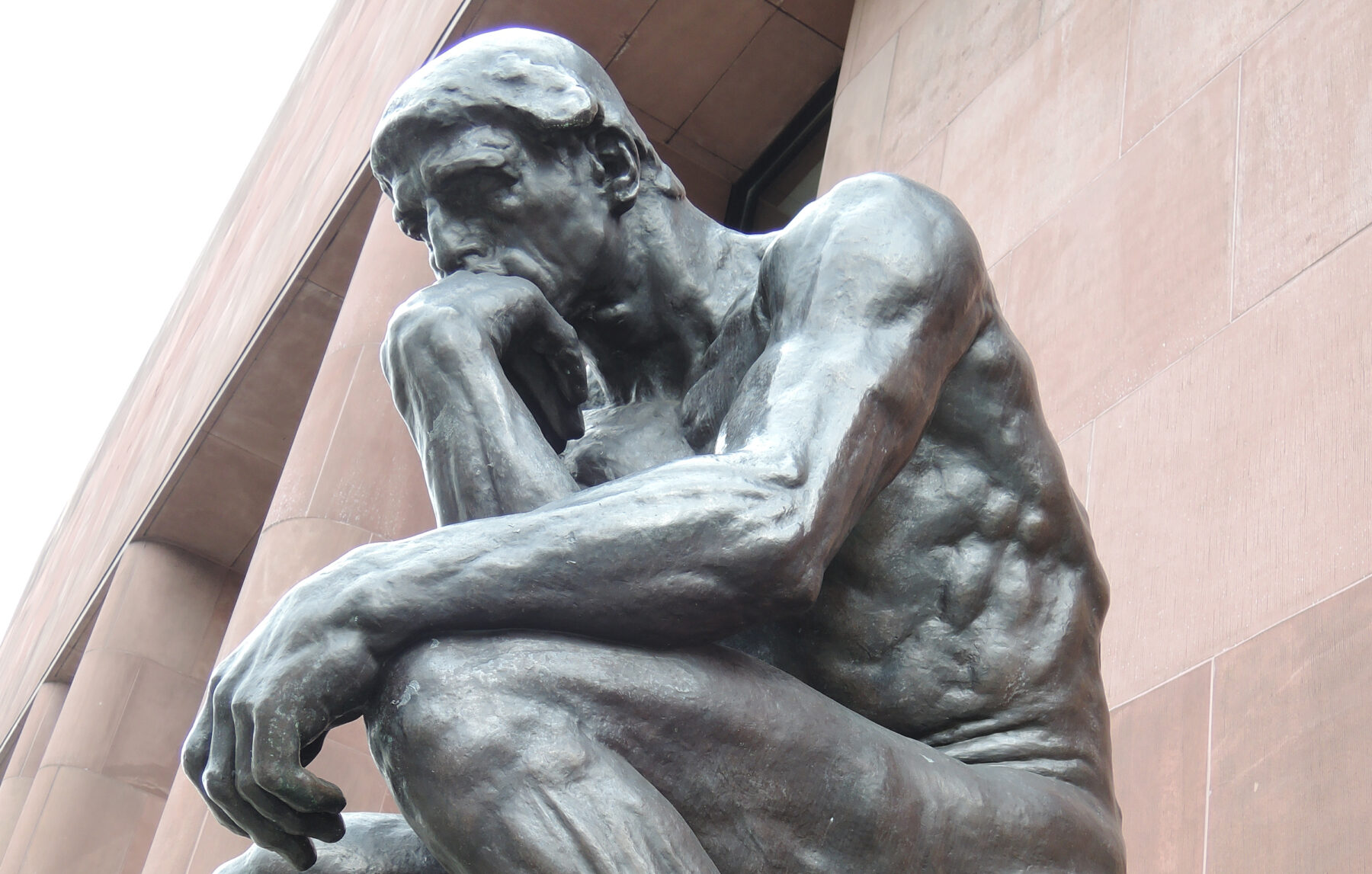
STEVE FULLER
What it means to be ‘human’ and whether the human must be the measure of all minds inevitably returns us to Kant. Kant himself was drawn to the concept of ‘judgement’, which he interpreted in terms of the then-emerging science of ‘aesthetics’. Aesthetics positioned the human as a being called to integrate diverse and often contradictory sensory inputs into a coherent whole in the name of ‘autonomy’, which is in turn exercised through judgement, which of course is also informed by reason. What modern philosophy calls ‘epistemology’ and ‘ethics’ reflects Kant’s view that human judgement forms two rather different but coexistent wholes as part of its ‘worldview’, another term from the aesthetic lexicon. The trajectory out of Kant to the German idealists, Schopenhauer and Nietzsche was largely about trying to achieve a higher, more synthetic aesthetic vision of the world, which typically involved what Nietzsche called a ‘transvaluation’ of the way we see the world from either a strictly epistemological or ethical standpoint.
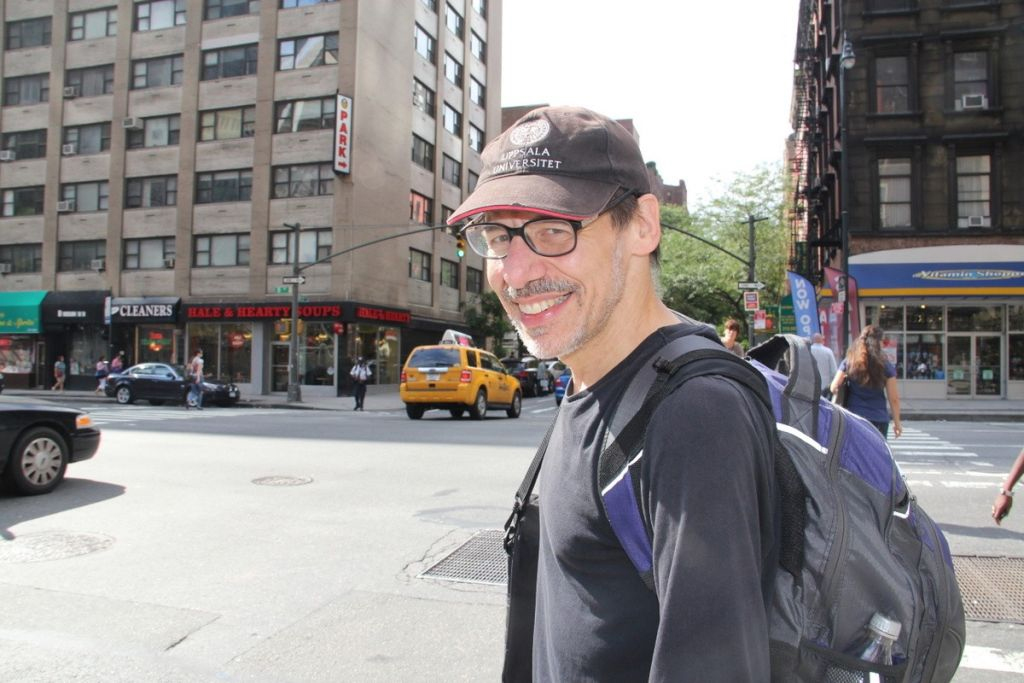
Steve Fuller
Senior Fellow at c:o/re (10/21-09/22)
Steve holds the Auguste Comte Chair in Social Epistemology in the Department of Sociology at the University of Warwick, England. This article is an opening statement for the 18-19 May workshop on ‘The Human Measure and the Measure of All Minds’.
Nietzsche’s somewhat ironic conclusion, already intimated in Kant, is that such a transvaluation would supplant the human with some other kind of being, which we nowadays might call ‘transhuman’ or ‘posthuman’. In effect, the sense of ‘judgement’ that defines the human for Nietzsche is not focused externally on the ultimate cosmic order but internally on the endless, perhaps even Sisyphean task of managing – if not reconciling – what we know and what we want. In this respect, Nietzsche continues to secularize Kant’s original theologically inspired vision of humans as fallen creatures. From this standpoint, the act of passing judgement on another’s humanity – as in the Turing Test – poses a challenge. It is outward looking but it treats the larger world – or more precisely, a candidate alien being – as a canvas on which to project the human; yet the human remains itself a bundle of contradictions, not a template that can simply be imposed.
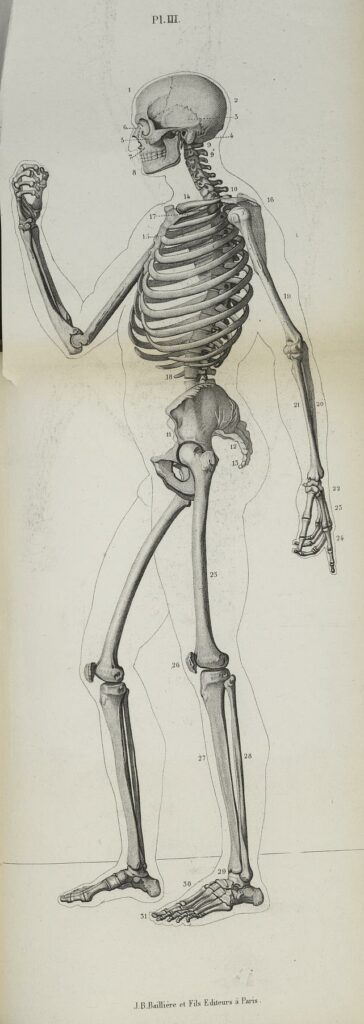
Recent aesthetic theory offers an interesting angle on this dilemma. Nelson Goodman famously proposed that art may be divided into those works that can be forged (because they constitute a unique completed object) and those that cannot be forged (because they can be completed in many ways). He had in mind the distinction between a painting or sculpture, on the one hand, and a musical score or dramatic script, on the other. Against this intuition, Arthur Danto proposed imagining that two artists generate paintings that appear the same to the observer but one used Rembrandt’s method and the other Jackson Pollock’s. Goodman might claim that subtle differences between the two paintings could always be found, based on which one painting might be judged superior and the other perhaps a forgery. However, Danto argues that Goodman’s judgement would probably be based on suspecting that the two paintings had been produced at different times and by different means. For Danto, if you like one, you should like the other. If anything, knowing that they were produced differently should enhance not detract from your aesthetic experience. The Pollock might even be valued more, given the prior improbability of its result.
Danto’s point was designed to undermine the idea of forgery. For him, unlike Goodman, an aesthetic judgement involves treating not only the future but also the past of a candidate work ‘performatively’. Just as we potentially learn something new about music or drama with each new performance, the same applies to our unlearning ideas about the ‘unique craftsmanship’ of a painting or sculpture upon realizing that it can be (and could have been) brought about differently. This sense of temporal symmetry dissolves Goodman’s original distinction. Of course, aesthetic judgement then gets more squarely placed on the shoulders of the judge – and in that sense, becomes more ‘subjective’. Indeed, Danto’s championing of Andy Warhol’s Brillo Box as art led many critics to claim that Danto dissolves the concept of art altogether.
Now applying Danto to Turing, does entertaining a comparably free — ‘morphologically free’, if you will — conception of the human undermine the very concept of humanity? Nietzsche believed that it might but remained agnostic about the consequences – and he was thinking only about how Homo sapiens might be transformed in the future. But why could we not also, á la Danto, discover ‘humans’ who never were Homo sapiens? Moreover, a practical question is attached to the idea of a morphologically free ‘human’. Is a more open conception of what passes as human sustainable in a world with finite resources in many different senses? Kant’s ideal of ‘cosmopolitanism’ suggested an indefinitely expanding circle of humanity, which he associated with collective self-improvement through sustained interaction with ‘alien’ others. Without denying the attractiveness of this ideal, its realizability remains an empirically open question, as non-stereotypically candidate ‘humans’ come forward for recognition.
Reference
Danto, A. (1974). ‘The Transfiguration of the Commonplace’. The Journal of Aesthetics and Art Criticism 33(2): 139-148.
Featured Image: Le Penseur by Rodin, CC BY SA.
Proposed citation: Fuller, Steve. 2022. Getting the Measure of Humanity: Or, Taking ‘Life is a Work of Art’ Literally, https://khk.rwth-aachen.de/2022/05/10/3243/3243/
Knowledge as capacity to act: takeaway from Professor Nico Stehr’s visit at c:o/re
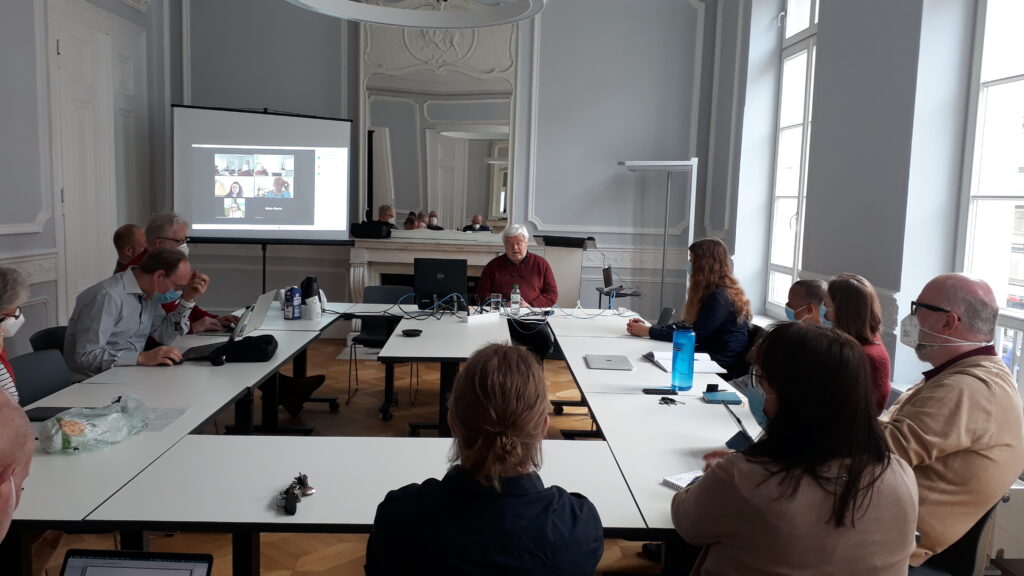
We are grateful for Professor Nico Stehr‘s visit at c:or/e during April 2022. It was a pleasure and most interesting to have with us a pioneer of the “knowledge society”, who has been at the forefront of research on culture, society and sustainability for many decades and, as such, is a defining figure for this disciplinary intersection. In an excellent talk titled “Competition among forms of knowledge or the limits of the power of scientific knowledge”, Professor Nico Stehr introduced the breadth and depth of his notion of knowledge as capacity for action. By construing knowledge as model both of and for reality, Nico Stehr offered a timely reflection on the relation between representation, interpretation and factuality. Surely, his work will remain essential to STS, as well as to other akin areas of research.
Very kindly, Professor Nico Stehr donated some of his books to our library. This collection of books is a glimpse of his scholarly legacy.
Interdisciplinary Research in Robotics and AI
Joffrey Becker and c:o/re RWTH Aachen University are hosting this workshop on April 20th 2022
Interdisciplinary Research in Robotics and AI
This workshop addresses interaction design by focusing on the notion of Behavioral Objects. Based on robotics and artificial intelligence, these non-anthropomorphic, non-zoomorphic objects are endowed with capacities for expressive movement, actions and reactions and are also able to elicit observers’ behavioral interpretations (intentional and emotional attributions). They are therefore of interest to many fields of research like social sciences, humanities, robotics, computer sciences, art and design. The workshop will address the interdisciplinary framework opened by Behavioral Objects and the experimental perspective that brings together and combines these disciplines.
To take part online, please register with events[at]khk.rwth-aachen.de
Program
12:00-02:00pm
The Apprentices: Objects with Interacting Behaviours
Samuel Bianchini (Reflective Interaction Research Group/EndsadLab, École nationale supérieure des Arts Décoratifs, PSL University), Elena Tosi Brandi (Xdlab/Art Directions Nods, Orange), Hugo Scurto (Inserm-Sorbonne Université and ISIR, CNRS Sorbonne-Université and Reflective Interaction Research Group)
The Appprentices is a design research project led by multidisciplinary teams from Orange Innovation and EnsadLab (the laboratory of the École des Arts Décoratifs, Paris). Following an experimental approach that combines human sciences (notably anthropology and cognitive sciences), robotics and computer sciences (machine learning) with digital creation and innovation, this project explores new relational modalities between humans and our robotic environments enhanced by artificial intelligence techniques. If our everyday objects might be empowered with abilities of movement and learning, action and reaction, and a behavioral dimension, how can we design new relationships with these robotic artefacts but also between them? This lunch talk will describe The Appprentices, an instrumental “dispositif” to experiment with such “behavioral objects”, focusing on an original dimension that allows movement and sound to be strongly paired: vibration, vibratory space as a system of communication and interaction. Specifically, the talk will detail the participatory design process that enabled practitioners and researchers from diverse disciplines to collaborate in the prototyping of the dispositif, in an attempt to entangle technical components of these robotic objects with concepts of agency, animacy, learning, and vibration.
Lunch
05:00 – 07:00pm
Behavioral Objects, Agonistic Objects. How and why to design art robotic objects fighting against and for their being conditions?
Samuel Bianchini (Reflective Interaction Research Group/EndsadLab, École nationale supérieure des Arts décoratifs, PSL University)
Created in an artistic context that also belongs to the wider field of robotics, “behavioral objects” are defined by their capacity to express a “personality” thanks to the quality of their movements and their actions and reactions, which are, in this case, regarded as “behaviors.” Non-figurative, these art objects have no need of being useful – their activity does not have a specific function or usage – and they have built-in energy sources that are, generally, not visible, making it impossible to attribute to a third party the energy directly required to make them move, the physical cause of their activity. If their expressive capacities can be provided through the ability to move and interact dynamically with the environment, what kind of interaction could we design to stimulate the attribution of behaviors and even personality? How to build an emotional and reflective relation with this robotics object through an aesthetic dimension in operation? Based on the presentation of several art projects developed in the framework of our Behavioral Objects research and creation project, we propose to consider the design of this objects through an agonistic approach. Even in operation, these objects are still in construction: in a kind of new homeostatic perspective, they are always seeking for their balance. They need to fight for that, against and for their being conditions. Exhibited such objects it is to exhibit this fight. It requires now to configure relations of forces, internal as with the environment. This new kind of settings as to consider aesthetic, symbolic and technical dimensions gathered in real-time operation. It raises the possibility of an agonistic design, a way to set conditions for a sensitive and reflective experience for objects and humans.
Dinner
Enlightenment Now
Steve Fuller, Frederik Stjernfelt and c:o/re are hosting this one-day workshop April 21st 2022
Enlightenment Now
In this seminar, we’d like to draw a line between recent intense research into the intellectual history of the Enlightenment and our present situation. What would Radical Enlightenment mean today? How would a 17-18th century Enlightenment view on our present predicament look like? – given pressing issues of academia today, the fate of the universities, the development of AI, tech, the new West-East cold war, populism, globalization, post/trans humanism, the future of humanity?
To attend online please register with events[at]khk.rwth-aachen.de
Program
10:00-11:00
Free Speech and Enlightenment: Lessons from the World’s First Full Press Freedom
Frederik Stjernfelt (RWTH Aachen/ University of Aalborg Copenhagen)
Abstract
September 14 1770, full press freedom was suddenly declared in Denmark-Norway by king Christian VII and his German favorite, the radical enlightener doctor J.F. Struensee. That signaled the beginning of the dramatic three-year Press Freedom period, effectively kickstarting modern debate in the double kingdom. In the middle of the period, there was a coup, Struensee was decapitated after a mock trial, and Press Freedom was slowly smothered. What can be learned from this strange event of the High Enlightenment?
11:00-12:00
Condorcet’s Predicament- can the democratic republic work?
Jonathan Israel (Institute of Advanced Study, Princeton)
Abstract
Those late Enlightenment figures such as Condorcet, Destutt de Tracy, Paine, Palmer and Barlow and others who had reason to feel profound disappointment and pessimism at the defeat of their plans during the 1790s and opening years of the nineteenth century, apparently nevertheless refused to give up hope of eventual success. But they could hardly avoid a lot of soul-searching and especially asking themselves what are the minimum requirements needed to ensure the stability, viability and survival of a modern democracy. Significantly, all of these tended to see the solution in restructuring, in fact revolutionizing education.
12:00 – 12:15
Coffee Break
12:15-13:15
In Favor of Patterns: Reviving an Enlightenment Ideal
Rens Bod (University of Amsterdam)
Abstract
There are two opposing traditions in the longue durée history of the humanities: one which searches for patterns and regularities (in texts, languages, art, music and the past) and one which rejects any notion of pattern and focuses on the unique and the exceptional. This opposition is found already in 250 BCE between the Analogist school of Alexandria and the Anomalist school of Pergamon and has not disappeared ever since. And yet, there have been periods when the search for patterns, regularities and underlying principles was dominant. The golden period of pattern-seeking was the Enlightenment: patterns were discerned in history by Vico, Condorcet and others, patterns were found in music to build musical grammars by Rameau and Koch among others, and principles were found to underlie languages (De Laet, Hemsterhuis), art (Bellori, Winckelmann) and literature (Boileau, Gottsched), not to speak about the search for patterns and principles in the natural world that has become dominant ever since. Very few of the Enlightenment patterns found in the cultural world have stood the test of time though, but the endeavor to try to understand the world by patterns and underlying principles remains a major feat of the Enlightenment. The opposition between patterns and the exceptional flared up again in the 19th century and arrived at a zenith after WWII with the advent of the Frankfurt School and the postmodern turn. And yet the search for patterns has recently shown a revival in the humanities with the appearance of new disciplines such as digital history, comparative global humanities, environmental humanities and digital humanities. I will show that the return to pattern-searching has also influenced the more traditional humanities disciplines, from philology to art history, and has resulted in a myriad of new discoveries in art, music, literature and history. I will argue that the revival of the Enlightenment ideal of pattern seeking may arguably be the only way for the humanities to survive.
13:15-15:00
Lunch Break
15:00-16:00
Kant Between Swedenborg and Linnaeus: A Fork in the Road to the Enlightenment’s Legacy
Steve Fuller (c:o/re RWTH Aachen/ University of Warwick)
Abstract
I am currently writing a play about a possible but fictional event that would have Kant travel from Königsberg to visit Carolus Linnaeus and Emanuel Swedenborg, who made their reputations in Uppsala. The lives of the three significantly overlapped in time, and Kant was significantly influenced by the two Swedes – to be sure, more positively by Linnaeus than by Swedenborg. However, the three never met. Even Linnaeus and Swedenborg are known to have only met once, namely, when Linnaeus turned over his Stockholm flat to Swedenborg in 1741. Nevertheless, the fictional encounter is significant for marking a fork in the road of the Enlightenment’s legacy, which becomes clearer in the later, ‘critical’ phase of Kant’s career, on which his own reputation as the foundational figure of modern philosophy is based.
My play takes place in 1756, the year after the famous Lisbon earthquake that inspired Voltaire to write Candide and provoked a wide-ranging discussion of theodicy across Europe, epitomized by the question: Do we live in a just world? In that year, Kant was 32, Linnaeus 49 and Swedenborg 68 – each belonging to a different generation. For Kant, Linnaeus was someone who understood the empirical limitations of the ape-like nature of the human condition better than Swedenborg, even though Swedenborg’s more adventurous speculations about the powers of the human mind were often based on a remarkably prescient understanding of the brain’s workings. Kant’s first book, Dreams of a Spirit-Seer (1766) was a comprehensive takedown of Swedenborg, which anticipated his later scepticism about ‘pure reason’.
The play is very much a work in progress, and I plan to discuss the various considerations that the two Swedes might try to bring to bear on Kant, who himself reaches a kind of divided judgement on the matter, which is reflected in his later strong distinction between ‘pure’ and ‘practical’ reason, which effectively has noumenon do double duty in the epistemological and ethical realms.
16:00 – 16:15
Coffee Break
16:15-17:15
The Enlightenment Now: The Human Skeuomorph://Public-Private
Cheryce von Xylander (Leuphana University Lüneburg)
Respondent: Steve Fuller (c:o/re RWTH Aachen/ University of Warwick)
Abstract
This talk about the deep, taken for granted legacy of the Enlightenment, is based on the technological capabilities that were unleashed and largely celebrated in the eighteenth century. Social platforms have migrated discursively from purveyor of a utopian future that would unite users in egalitarian online activity to public enemy that threatens to wreck the democratic cultural order. This trajectory from paragon to pariah has much to teach us about human self-fashioning in the advanced capitalist, neoliberal dreamscape. It should give pause that a service sector that arose from the defence arsenal of the military-industrial complex ever inspired blind faith in its potential to better the human condition. An epistemic prosthetic as powerful as the vast knowledge repository that is the internet will rework cognition. The online industry is forever aggregating digital traces of enacted rationality. This smart techno-habitat systematically conceals what it emphatically re-enacts, namely figuration of the modern user as an aesthetic contrivance conjured in the eighteenth century. I propose to call this enabling latency the human skeuomorph. Skeuomorphism is a concept used by archaeologists to describe aesthetic attributes that outlast their utility in tool evolution. Like other tools in the archaeological record, the human skeuomorph has been subject to material transformations, yet persists as a semiotic undercurrent. The retooling of this apparition in new media will hinge on future interpretations of its Enlightenment past.
17:15 – 17:45
Closing Discussion

